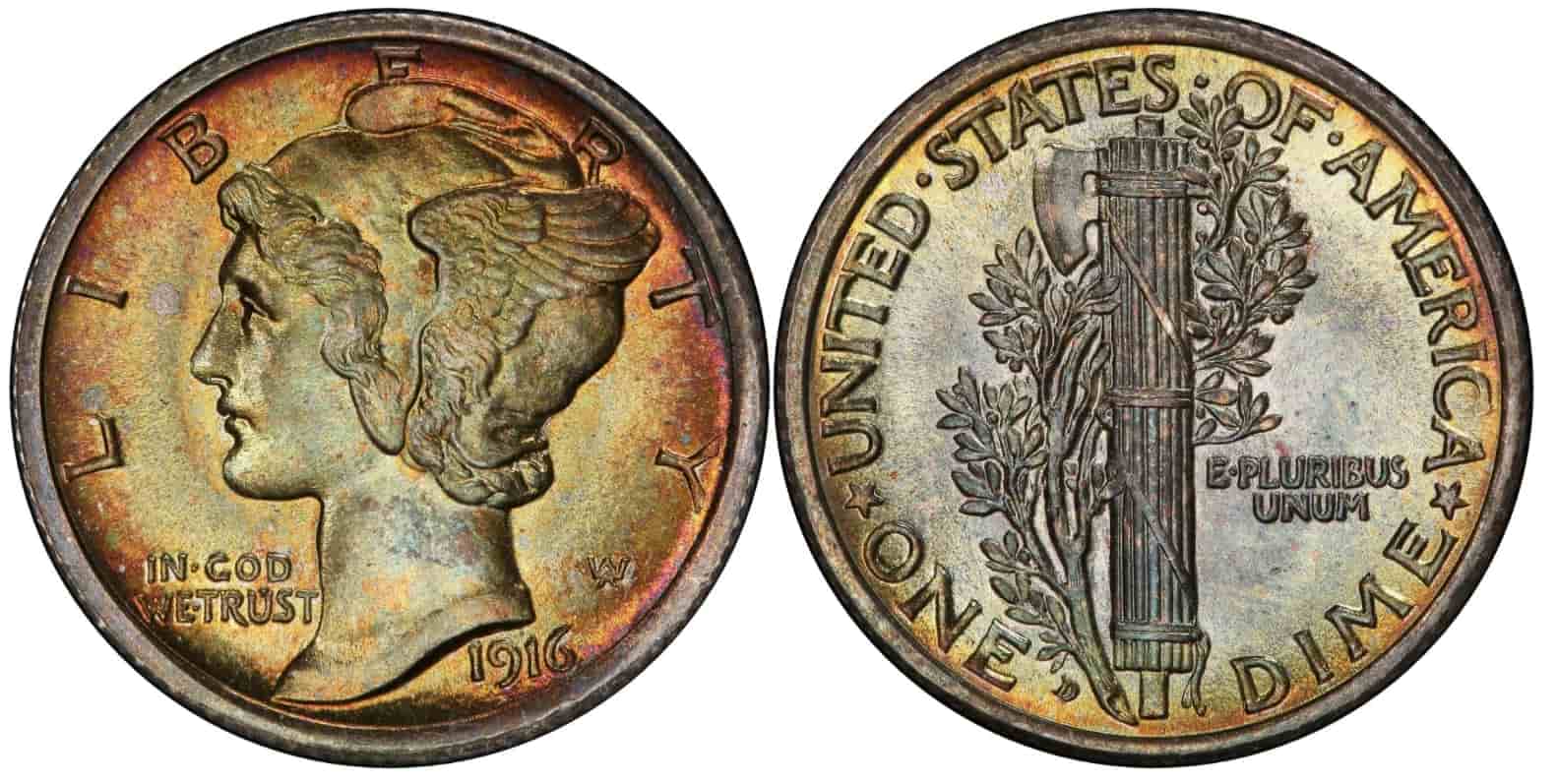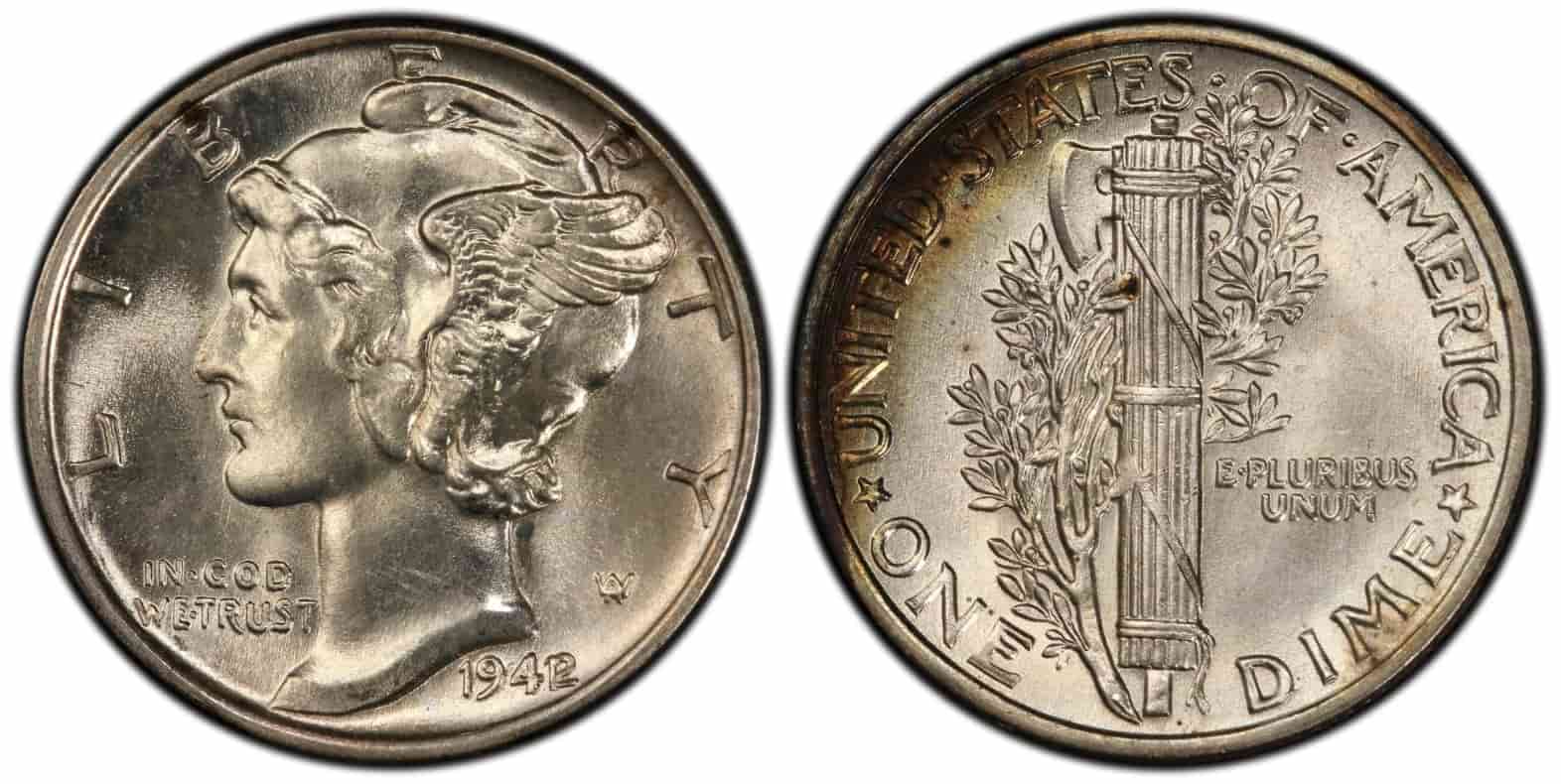Mercury Dime Value Guide
Posted by Andrew Adamo - A certified ANA Professional Numismatist, Active member of ICTA, contributor to CoinWeek, Numismatic News, NGC and ANA on May 27th 2025
Mercury Dime Value Guide (1916 – 1945)
Mercury dimes have fascinated collectors since they first appeared in 1916. Made of 90 % silver, most are worth only a few dollars over their melt value. But certain years, mint mistakes, and coins with crisp “Full Bands” details can sell for thousands—or even hundreds of thousands—of dollars. Knowing these key factors helps you tell an ordinary dime from a true rarity. Continue reading our Mercury Dime Value Guide to learn more.

AUCTION RECORD: $207,000 • MS67 • 08-11-2010
How much is a Mercury dime worth?
Most worn (Good–Fine) Mercury dimes are worth about $2.40–$5—just above their silver melt value (0.07234 troy oz × today’s $33.29 spot = $2.41). Scarce dates, major errors, and sharply struck “Full Bands” (FB) coins can bring $100 - $250,000+. A 1916-D in PCGS-graded MS67 FB fetched $207,000 at auction, while a 1942/1 over-date in MS66 FB realized $120,000 PCGS.

AUCTION RECORD: $120,000 • MS66FB • 01-03-2018
Table of contents
1. Complete Mercury-Dime Value Table (Good 4 → MS 65/67)
| Year | Mint | G-4 | VF-20 | XF-40 | AU-55 | MS-65 | MS-65 FB |
|---|---|---|---|---|---|---|---|
| 1916 | P | $8 | $18 | $60 | $100 | $125 | $550 |
| D | $1,550 | $3,750 | $8,500 | $15,000 | $27,500 | $87,500 | |
| S | $9 | $32 | $70 | $130 | $215 | $1,050 | |
| 1921 | P | $60 | $175 | $425 | $800 | $2,100 | $— |
| D | $100 | $325 | $925 | $1,600 | $4,300 | $50,400 | |
| 1926-S | S | $5 | $20 | $65 | $225 | $450 | $3,500 |
| 1931-D | D | $3 | $15 | $28 | $90 | $225 | $1,000 |
| 1942/1 | P (over-date) | $250 | $550 | $1,200 | $2,400 | $4,000 | $120,000 |
| Common dates (avg.) | P/D/S | $2.50 | $4 | $8 | $18 | $28-35 | $140-275 |
Data extracted 05-27-2025 from the PCGS Price Guide and recent auction results PCGS
(FB = “Full Bands”; values are retail estimates—actual dealer offers and auction results vary by eye-appeal, toning, and certification service.)
2. Key-Date Spotlights
1916-D — Series King
-
Mintage: 264,000 (lowest of series)
-
Why it’s rare: First-year issues from Denver saw heavy local circulation; few survived in Mint State.
-
Record price: $207,000 (PCGS MS67 FB, Heritage, Aug 2010)
-
Counterfeit alert: Look for the mint-mark’s position—it should sit left of the fasces, level with the E in ONE. Soft rims and “filled-D” shapes are red flags.
1921 & 1921-D — Post-war silver shortage
-
Mintages dipped while resources were diverted after WWI. In MS65 the 1921-D exceeds $4 k, and FB coins have topped $50 k PCGS.
1942/1 & 1942/1-D — Famous over-date
-
A hubbing error left the numeral 1 below the 2 in the date—visible even on circulated pieces.
-
Top certified example reached $120,000 (MS66 FB) PCGS.
1926-S — Sleeper rarity
-
Lowest surviving MS population of the mid-1920s. MS65 FB coins sell in the $3 k-plus range.
3. Error & Variety Gallery
| Error type | How to spot it | Approx. value* |
|---|---|---|
| Off-center strike | Blank crescent-shaped rim; look for 5-10 % off center to retain date | $75-400 |
| Broad-strike | No raised rim; design stretches to edge (common on 1940s coins) | $40-150 |
| Clipped planchet | Straight or curved “bite” out of coin | $60-250 |
| Wrong planchet (dime on cent blank) | Silver dime size but copper color / weight 3.11 g | $2,000-10,000 |
| Cud / Die-break | Raised blob at rim; premiums jump if it touches the date or Liberty’s face | $50-300 |
*Typical retail for uncertified pieces; certification and dramatic appearance can multiply prices.
4. What “Full Bands” Means—and Why It Matters
On the reverse, Liberty’s fasces has two sets of horizontal bands. If both sets show separate, unbroken lines, third-party graders append the coveted FB (PCGS) or Full Split Bands (NGC) designation. True FB strikes prove exceptional die pressure and minimal wear—population reports show fewer than 1 in 15 high-grade Mercury dimes earns the mark. Premiums range from 2× on common dates to 10×-plus on key issues like 1919-S and 1945-S PCGS.
How to check:
-
Use 5-10× magnification under white LED light.
-
Examine the upper and lower bands separately—both must be fully split.
-
Confirm no bridging or wear spots interrupt the lines.
5. Live Melt-Value Formula
A Mercury dime weighs 2.5 g of 90 % silver → 0.07234 troy oz of pure Ag. To estimate melt:
Spot-Price (oz) × 0.07234 = Melt Value
Example (May 27 2025): $33.29 × 0.07234 = $2.41
(Our price table auto-updates monthly as silver moves.)
6. Buying, Selling & Grading Tips
-
Where to buy: Certified key-dates and high-grade commons are listed in our Mercury Dimes inventory and on our weekly e-auction platform. Raw silver-value lots appear in our Daily Deals section for stackers.
-
Selling: Submit photos via our free appraisal form or call for a same-day bid. We pay 90–95 % of PCGS guide for slabbed key dates and spot × weight for bulk silver.
-
Grading: PCGS and NGC dominate auction premiums. For borderline FB strikes, PCGS tends to drive stronger realized prices. Coins worth $150+ in MS60 or better generally justify certification fees.
-
Storage: 2×2 cardboard flips work for bulk silver; invest in inert capsules for MS coins to prevent milk-spots and slide friction.
7. Collector FAQ
| Question | Short answer |
|---|---|
| Are Mercury dimes made of mercury? | No—“Mercury” is a nickname because Liberty’s winged cap resembles the Roman god. The alloy is 90 % silver, 10 % copper. |
| Which Mercury dime is the rarest? | The 1916-D in uncirculated + FB condition; fewer than 100 pieces are graded MS65 or finer. |
| Why were no dimes struck in 1922? | The Mint had adequate stocks left from 1921; thus no dimes (or nickels) were produced in 1922. |
| What’s the cheapest key date to collect? | The 1931-D remains under $300 in MS-65, making it an accessible semi-key. |
| Can I find Mercury dimes in circulation? | Extremely unlikely; most were withdrawn in the 1960s. Coin-star reject trays or estate coin jars are your best bet. |
| Do cleaning or jewelry mounts hurt value? | Almost always—expect a 50-90 % reduction versus original-surface coins. |
| How do I tell a 1942/1 over-date? | Look for a faint “1” under the “2”—especially the serif below the top curve. Magnification is needed on lower grades. |
| What’s the difference between FB and non-FB premiums? | Commons: ~2×; semi-keys: 5–8×; major keys: up to 10×+. |
| Are proof Mercury dimes rare? | Yes—proofs were struck only 1936-1942, with mintages under 5,000 per year. |
| When will the next price update be? | We update melt and auction comps the first week of every month—bookmark this guide! |
Sources
-
PCGS Mercury Dime Price Guide, updated May 27 2025 PCGS
-
1916-D auction record (PCGS MS67 FB) PCGS
-
1942/1 auction record (PCGS MS66 FB) PCGS
-
1921-D population & record price data PCGS
-
Silver melt calculations from NGC melt-value index NGC Coin
-
Mainstream coverage of Mercury-dime “treasure hunts” (The Sun, 2024)
Ready to own a piece of classic Americana?
Browse the latest certified Mercury dimes—or request a custom want-list—through Bullion Shark’s rare-coin desk today.
Continue reading:
9 of the Most Valuable State Quarter Errors Worth Money
Top 10 Rare State Quarters Worth Money
2009 Penny Error List – The Complete Collector’s Guide
2009 Penny Value: How Much is a 2009 Penny Worth Today?
Chasing the ‘W’: How 2019 West Point Quarters Became the Decade’s Hottest Collectibles


